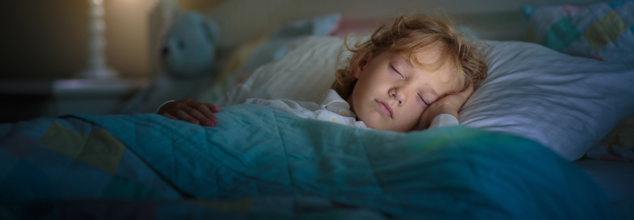- Health Conditions A-Z
- Health & Wellness
- Nutrition
- Fitness
- Health News
- Ayurveda
- Videos
- Medicine A-Z
- Parenting
- Web Stories
How Sleep Deprivation In Kids Hurt The Entire Family!

(Credit-Canva)
We all know how important sleep is, not sleeping enough can lead to many different issues, whether it is mental or physical. But is it the same for kids? Kids seem like they have boundless energy. They do eventually exhaust themselves, but given the opportunity, they will still run around and enjoy themselves. But does lacking sleep cause children to suffer the same consequences as adults? Getting enough sleep is super important for everyone in the family. It helps kids grow, learn, and feel good. It also helps parents stay calm and handle stress. Making a good sleep routine is like building a strong foundation for your family's health. It makes everyone feel better, both physically and emotionally. When everyone sleeps well, the whole family benefits.
How Lack Of Sleep Affects Kid’s Mental Health
Studies suggest that kids lacking sleep aids in them having mental health issues. If kids don't get enough sleep for a long time, it can change how they feel. They might start feeling sad or worried more often. According to a 2024 study published in the Sleep Advances Journal, kids who have trouble sleeping are more likely to have problems like ADHD, which makes it hard to focus. Sleep is like a cleanup crew for the brain. While you sleep, your brain organizes memories and fixes problems from the day. If you don't sleep, your brain can't do its cleanup work, and this can make it hard to learn and control your feelings.
Good sleep helps kids learn to control their feelings. According to a 2017 study published in the Neuroscience, sleep helps them learn how to manage their emotions, which is important for dealing with life. When kids sleep well, they can handle stress and problems better. Even small sleep problems, like having trouble falling asleep, can make it harder for kids to handle everyday stress. Getting enough sleep helps kids build strong emotional skills.
When Kids Sleep Well, So Do Parents
Not getting enough sleep doesn't just hurt kids; it hurts parents too. Lack of sleep makes parents more stressed and less able to handle problems. When parents don't sleep well, they can feel angry, confused, and worried. A 2019 study published in the Sleep journal showed that parents lose a lot of sleep in the first six years of a child's life. It's hard for parents to take care of their kids when they are also tired. Parents need good sleep to stay healthy and happy. A well-rested child often means fewer nighttime disturbances, leading to more restful sleep for parents. Here are some ways you can create a healthy sleep schedule for kids.
Creating Good Sleep Habits
A consistent bedtime trains the body's clock, leading to deeper sleep and improved focus in school. Regularity builds a predictable rhythm for healthy rest.
Have a calming bedtime routine
Quiet activities like reading signal the brain to wind down. A soothing routine promotes relaxation, making it easier for children to fall asleep peacefully.
Limit screen time before bed
Blue light from screens disrupts melatonin, the sleep hormone. Turning off devices an hour before bed allows the brain to prepare for rest.
Make the bedroom dark, quiet, and cool
A comfortable sleep environment fosters uninterrupted rest. Darkness, silence, and a cool temperature help the body achieve optimal sleep quality.
Good sleep helps everyone
Adequate sleep regulates mood and reduces irritability. A well-rested family experiences less tension and improved emotional well-being overall.
Parents, Have You Given Your 12-Year-Old A Smartphone? Global Study Links Early Use To Serious Mental Health Risks

Credits: Canva
A smartphone in the hands of a child might look harmless—useful, even. It offers parents peace of mind, connects children with friends, and provides access to learning tools. But new research suggests that early smartphone ownership could carry a hidden cost that lasts well into adulthood.
A global study involving more than 100,000 participants has found that young adults who first received a smartphone before age 13 report significantly worse mental health, including higher rates of suicidal thoughts, aggression, detachment from reality, and low self-worth. The findings, published in the Journal of Human Development and Capabilities, point to a troubling association: the younger a child is when they first own a smartphone, the greater their risk of long-term emotional and psychological struggles.
The research, led by Sapien Labs through its Global Mind Project—the world’s largest mental wellbeing database—focused on individuals aged 18 to 24. Those who had smartphones at 12 or younger consistently scored lower on the Mind Health Quotient (MHQ), a tool that measures social, emotional, and cognitive wellbeing.
Young adults who received their first smartphone at 13 averaged an MHQ score of 30.
Those who had one by age five averaged just 1—a near collapse in mental wellbeing indicators.
Symptoms tied most strongly to early smartphone ownership included suicidal thoughts, increased aggression, detachment from reality, and hallucinations.
The analysis showed the effects were consistent across cultures, languages, and regions, underscoring what researchers describe as a “critical window of vulnerability” during childhood development.
Why Early Smartphone Use Affects Mental Health?
Smartphones are not simply phones—they are portals into social media, gaming, and AI-driven feeds that shape how children perceive themselves and the world. Dr. Tara Thiagarajan, neuroscientist and lead author of the study, explains:
“Our data indicate that early smartphone ownership—and the social media access it often brings—is linked with a profound shift in mind health and wellbeing in early adulthood.”
Children under 13 appear to be particularly vulnerable to cyberbullying, poor sleep quality, and weakened family relationships, all of which can accumulate into mental health symptoms later in life. The study estimates that early access to social media accounts for about 40% of the association between smartphone ownership and adult mind health, with disrupted sleep and family strain contributing significantly as well.
How Screentime Is Impacting Kids Mental Health?
Traditional studies on screen time often focus narrowly on depression and anxiety. What makes this research stand out is its broader scope. Symptoms like aggression, detachment from reality, and suicidal ideation are not always captured in conventional mental health assessments. Yet these outcomes, according to the study, are rising sharply among younger generations and carry serious societal implications.
For instance, the proportion of young women classified as “distressed or struggling” rose by 9.5% when they received a smartphone before age 13. For men, the increase was 7%. While females often reported lower self-image and emotional resilience, males showed diminished calmness, empathy, and stability.
Are Smartphones Are A Boon Or Bane?
Since the early 2000s, smartphones have reshaped how young people learn, communicate, and build identity. Yet the same technology that holds out hope of connectivity also generates comparison, isolation, and access to toxic content. The recommendation algorithms that utilize AI technologies accelerate these dynamics, keeping kids trapped in scrolling loops that tend to replace sleep, face-to-face engagement, and family time.
While most social media sites limit accounts to people 13 and up, regulation is lax. As such, children as young as eight frequently set up accounts and partake in content intended for much older viewers.
Governments are starting to act. France, Italy, the Netherlands, and New Zealand have placed limits on the use of phones within schools. In the United States, states such as New York, Alabama, and Arkansas have enacted or proposed similar measures. Initial statistics from the Netherlands indicate these interventions enhance concentration in class, but the long-term mental health effects are uncertain.
Though the study doesn't establish causation, it can't conclusively state that smartphones lead to mental health downturns—it shows a robust and consistent relationship in various populations. Researchers note that other factors, including the COVID-19 pandemic, might have amplified these trends. Nevertheless, the size of the issue, impacting millions of young adults globally, is too large to overlook.
The argument about teen smartphone use is not merely about personal health, it's about the health of societies as a whole. Increasing levels of suicidal ideation, violence, and disconnection among young people have ripple effects, from compromised healthcare systems to reduced workforce productivity and eroded community ties.
By comparing the situation to existing restrictions on alcohol and tobacco, scholars contend that societies already possess blueprints for protecting children from dangerous substances and settings. The problem is finding the political will and interagency cooperation to apply those protections to the online world.
Rising Cases Of Infant Deaths In Mississippi, State Declares Public Health Emergency

Credits: Canva
Mississippi health officials have declared a public health emergency after newly released data revealed the state’s infant mortality rate has surged to its highest level in more than a decade.
According to the Mississippi Department of Health, 9.7 infants died for every 1,000 live births in 2024, nearly double the latest national average of 5.6. Since 2014, more than 3,500 Mississippi infants have died before their first birthday.
Infant Mortality: A Growing Nationwide Concern
The state’s declaration highlights a broader national problem. Even in cities with advanced healthcare systems, disparities persist. For instance, Boston’s latest data shows Black infants dying at more than twice the rate of the city’s overall population, and triple the rate of White infants, despite Boston’s overall infant mortality being lower than the U.S. average.
Public health experts say the numbers underscore the deep impact of structural inequities, which go beyond individual health behaviors or access to clinical care.
“Every single infant loss represents a family devastated, a community impacted, and a future cut short,” said State Health Officer Dr. Dan Edney, who announced the declaration. “We cannot and will not accept these numbers as our reality.”
What Is Driving Mississippi’s High Infant Death Rate?
The leading causes of infant death in Mississippi include congenital malformations, premature birth, low birthweight, and Sudden Infant Death Syndrome (SIDS).
Racial disparities remain stark, Black infants are more than twice as likely as White infants to die before their first birthday, and recent state data suggests the gap is widening.
Declaring a public health emergency for infant mortality is highly unusual. But experts say the move is a necessary acknowledgment of the crisis.
“This elevates infant mortality to the level of urgent crisis response, which it truly is,” said Dr. Michael Warren, Chief Medical and Health Officer at March of Dimes.
Why The Emergency Declaration Matters
State officials say the declaration will allow them to act more swiftly to address gaps in maternal and infant care. Planned measures include:
- Expanding prenatal services in counties without obstetric providers
- Creating an obstetric system of care to regionalize services and improve emergency transfers
- Strengthening home visiting and community health worker programs
“Improving maternal health is the best way to reduce infant mortality,” Dr. Edney emphasized.
Experts, however, caution that focusing solely on medical interventions is not enough. Poverty, housing instability, transportation barriers, and lack of continuous care all play major roles in infant health outcomes.
Cuts To Federal Programs Complicate Response
Mississippi’s crisis is unfolding as federal funding for maternal and infant health programs faces major cuts.
The Pregnancy Risk Assessment Monitoring System (PRAMS), a CDC program that collected state-level data on maternal and infant health, was targeted for elimination this year, with dozens of staffers laid off in June.
Mississippi had relied on PRAMS to monitor trends like postpartum care, unsafe sleep practices, and maternal behaviors before and during pregnancy. Without it, experts warn the state is “flying blind.”
“It’s willful ignorance to cut vital maternal and child health programs when we have crises of both maternal and infant mortality,” said a former CDC staffer affected by the cuts.
The Role Of Medicaid In Infant Health
Medicaid finances nearly 6 in 10 births in Mississippi, compared with about 4 in 10 nationally. The state recently extended postpartum Medicaid coverage from two months to a year, a move public health experts welcomed.
But Mississippi remains one of 10 states that has not expanded Medicaid under the Affordable Care Act. As a result, many low-income women lack coverage before and between pregnancies.
Other states that expanded Medicaid, such as Louisiana, Arkansas, and Colorado—saw declines in infant mortality, particularly among Black infants. Nationally, expansion states recorded a 50% greater reduction in infant deaths than non-expansion states.
For more than a century, infant mortality has been viewed as a reflection of overall societal health. Sociologist W.E.B. Du Bois once argued that high rates among Black families were driven by inequities in living conditions, not innate differences, a truth that still resonates today.
Mississippi’s declaration is an attempt to rally hospitals, state agencies, and communities toward a unified response.
“It will take all of us working together to give every child the chance to live, thrive, and celebrate their first birthday,” Dr. Edney said.
Inner Child: Emotional Neglect, Not Just Abuse, Can Scar A Child For Life

Credits: Health and me
Inner Child is Health and Me's new mental health series where we deep dive into lesser-known aspects of child psychology and how it shapes you as you grow up. Often unheard, mistaken, and misunderstood, in this series we talk about the children’s perspective and their mental health, something different than you might have read in your parenting books. After all, parenting is not just about teaching but also unlearning.
Child development is often measured by milestones: first steps, first words, first day of school. Yet beneath these visible markers is a much deeper foundation that is far less obvious but far more critical- emotional security. A child might be fed, dressed, and protected, but still struggle if the critical attachment of responsive care is lacking. How does a lack of attention, affection, or regular emotional support influence a child's brain, behavior, and lifelong mental health?
Think of two children in vastly different environments. One is immersed in play, exploring new objects with curiosity and assurance, absorbed in discovery and learning. The other, raised without consistent emotional connection, may hesitate, withdraw, or even appear disinterested, despite having all physical needs met. These differences highlight an even deep reality- emotional abandonment—subtle, quiet, and easily invisible, can leave wounds as deep as overt cruelty. Learning about these effects is important not just for parents and caregivers, but also for educators, policymakers, and anyone who cares about helping resilient, healthy children.
When we talk of child development, the first thing that comes to mind is usually physical care- food, hygiene, shelter. But as decades of psychological research show, these essentials are insufficient in a child's emotional life, the feeling of security, responsiveness, and attachment is equally as important. Emotional neglect, even without overt abuse, can produce long-lasting, deep scars on a child's brain, behavior, and social-emotional development.
Child Development: Role of a Nurturing Environment
Kids brought up under supportive family environments have remarkably distinct behaviors from those bereft of emotional nurturing. Emmanuel, for instance, is one brought up in a safe and responsive family. The world is explored by him with fearless wonder. When presented with a new object, he investigates it meticulously, shifting it from hand to hand, even taking it to his mouth to comprehend its sensation. He is completely absorbed in the process, indifferent to the people around him.
In the same way, Christine, who participates daily in a nurturing nursery setting, handles objects deliberately, inquisitively. She places blocks on top of each other, retrieves them when they tumble, and is completely engaged in the activity. Both children illustrate how safety, focus, and warmth promote curiosity, learning, and confidence.
These are just a few of the examples that are a demonstration of what psychologists call emotional safety—the safe base that enables a child to concentrate, play, and learn without constantly having to guard against psychological harm.
When Emotional Neglect Interrupts Development in Babies
The profile is altered radically in youngsters with emotional neglect or who are taken away from home because of dangerous conditions. Caroline, who has been the victim of maternal neglect, shows very little interest in playing. She touches a block fleetingly but promptly becomes distracted, glancing about the room and the adults in the room. Her interest is fleeting, her curiosity dampened.
Veronique, a second child in an environment of emotional deprivation, shows avoidance behaviors, raising her arms to exclude contact and showing anxiety during object-handling. Jean, taken away from several placements and institutionalized, maintains intense focus on the psychologist's movement instead of investigating his environment. This is a vital psychological development: emotionally deprived children will turn social contact into a replacement for maternal interaction often at the cost of learning or curiosity.
Annette and René mirror one another's withdrawal patterns. René remains still, later trying to engage with objects but beset by fright, then retreating to thumb-sucking as a self-calming activity. Annette, completely uninterested in her environment, manifests physiological distress, from abnormal breathing to twitching lips. Colette, a similarly emotionally starved child, manifests autism-like symptoms and increased anxiety, staying rigid with labored breathing and glazed expression.
These behaviors are not discrete incidents—they represent a larger, troubling trend. Neglect of emotions stifles a child's sense of exploration, curiosity, and wonder about the world. In extreme cases, it may even lead to symptoms of autism spectrum disorders.
How to Become Better Parents?
The consequences of emotional neglect have been around for a while. In the 1940s, psychoanalyst René Spitz did some path-breaking research on institution-reared babies who did not have regular caregivers. Spitz found that when fundamental physical needs such as food and diapers were provided, infants showed stunning developmental problems: loss of interest, delayed development, vacant stares, immobility, and shutting off from emotions.
Spitz's research proved a basic truth: infant development hinges on attachment, not only on nurturing. Without responsive care, an infant's brain changes from discovery to self-defense. Play, learning, and interaction give way to watchfulness, apprehension, and withdrawal.
What Is Emotional Neglect?
Unlike physical abuse, emotional neglect can be out of sight. Parents or caregivers can give a child whatever they need in terms of material goods but not give responsive attention, affection, or validation. Neuroscientifically, this neglect impacts the developing brain in complex and lasting ways. Neural circuits used for emotion regulation, stress response, and social engagement are impaired, making children more susceptible to anxiety, depression, and social withdrawal as adults.
Psychologists insist that responsive parenting is not spoilage. Offering connection, attention, and emotional resonance does not produce "spoiled" kids. Instead, it shields babies from premature shutdown, fostering healthy brain development before they even have words to articulate their needs.
How Emotional Neglect Reflects And Impacts Children?
Emotional neglect has long-reaching consequences for a child's lifetime. Lowered curiosity, restricted exploration, and increased anxiety in early childhood may mean trouble with learning, relational connections, and stress management during adolescence and adulthood. Children lacking steady emotional support are at risk of mental health disorders, such as depression, anxiety disorders, and emotion regulation difficulties.
From a public health standpoint, these results underscore the need for early intervention, awareness, and parenting support programs. Having caregivers who can provide emotional responsiveness can help mitigate the long-term effects of neglect and encourage healthier developmental paths.
How Can Parents Create Emotional Safety?
It is not difficult to create emotionally safe spaces, but it does take intentionality. Practices suggested by psychologists include:
Engaging in attentive and consistent interaction with the child.
- Validation of the child's experience and feeling.
- Gentle redirection instead of punitive reactions to exploring or making errors.
- Chances for discovery and free play in a safe context.
- Even small, consistent acts of responsiveness can have a significant impact on a child's emotional and intellectual development.
- Emotional neglect is no less harmful, if not more subtle, than physical abuse. Children denied predictable care and attention might live on, but brains and emotional lives suffer dearly. Caroline's, Veronique's, René's, Annette's, and Colette's histories demonstrate the severe consequences of neglect: anxiety, withdrawal, stifled curiosity, and in extreme circumstances, autistic-like behaviors.
What these studies reveal is that child development starts with attachment. Responsive parenting is not a choice, but a necessity. It creates the safety children require to experiment, learn, and develop into strong, capable individuals. Simply put, emotional safety isn't a nicety, but a requirement for mental and emotional well-being for a lifetime.
© 2024 Bennett, Coleman & Company Limited

